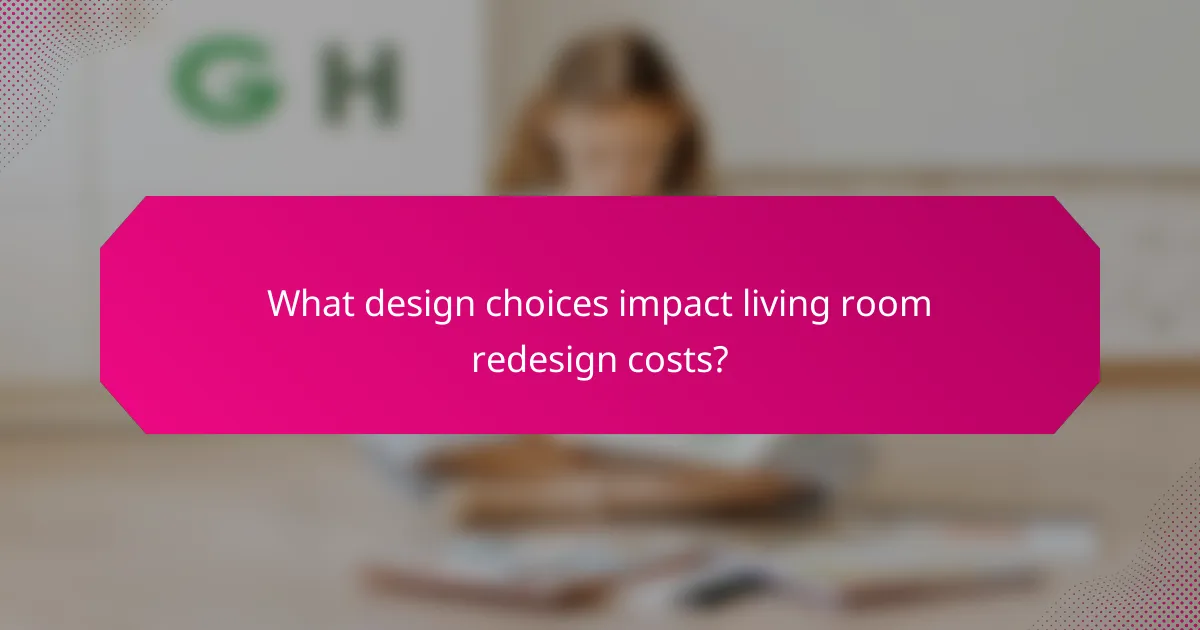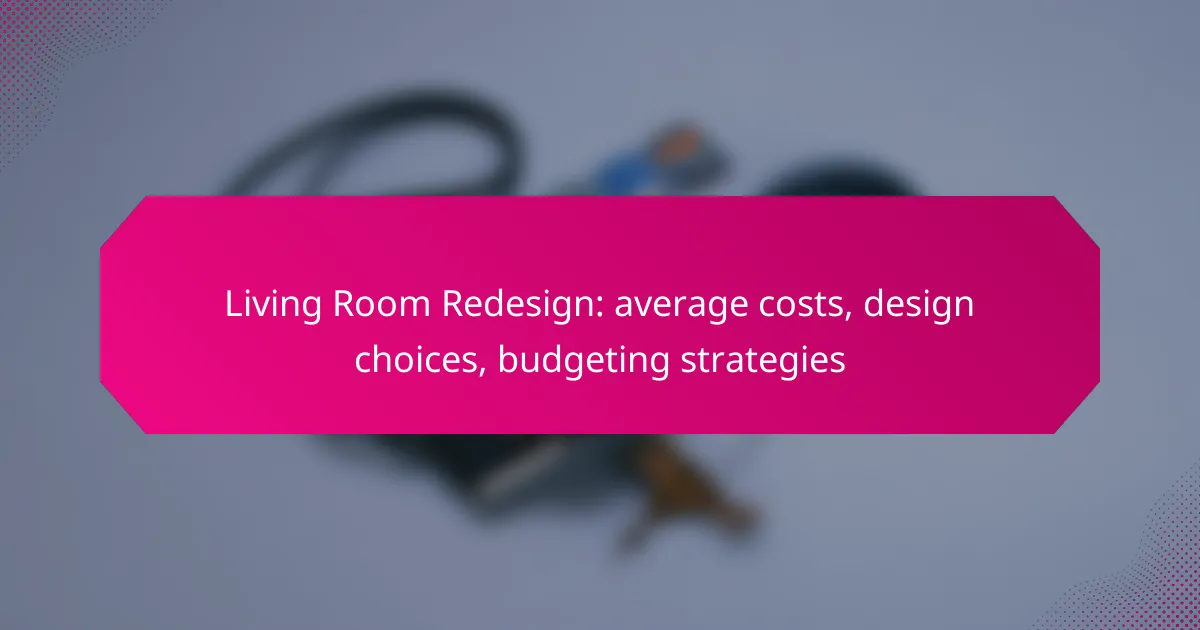Redesigning your living room can be an exciting yet challenging endeavor, with costs varying widely based on project scope and material choices. Homeowners in the UK typically face expenses ranging from a few hundred to several thousand pounds, influenced by factors such as furniture selection, wall treatments, and lighting. Effective budgeting is essential to navigate these costs, allowing you to prioritize design elements while preparing for any unexpected expenses that may arise.

What are the average costs of living room redesign in the UK?
The average costs for a living room redesign in the UK can vary significantly based on the scope of the project and the materials used. Generally, homeowners can expect to spend anywhere from a few hundred to several thousand pounds, depending on whether they opt for a basic, mid-range, or high-end redesign.
Cost range for basic redesign
A basic living room redesign typically costs between £1,000 and £3,000. This budget usually covers essential updates such as painting, new furniture, and minor decor changes. Homeowners can save money by choosing budget-friendly options and focusing on a few key elements.
Consider DIY projects for tasks like painting or assembling furniture to further reduce costs. Prioritize items that will have the most impact, such as a new sofa or a fresh coat of paint.
Cost range for mid-range redesign
For a mid-range redesign, expect to invest between £3,000 and £10,000. This range allows for a more comprehensive overhaul, including quality furniture, upgraded lighting, and better decor. Homeowners might also consider hiring a designer for professional input.
When budgeting, think about the balance between aesthetics and functionality. Investing in durable materials can save money in the long run, as they often require less maintenance and replacement.
Cost range for high-end redesign
A high-end living room redesign can cost upwards of £10,000, with some projects exceeding £30,000. This level of investment typically includes custom furniture, high-quality finishes, and professional design services. Homeowners should be prepared for a detailed planning process and possibly longer timelines.
When considering a high-end redesign, focus on creating a cohesive look that reflects personal style. Collaborating with experienced designers can help ensure that the final result meets both aesthetic desires and functional needs.

What design choices impact living room redesign costs?
The design choices you make in a living room redesign significantly influence overall costs. Key factors include furniture selection, wall treatments, lighting options, and flooring materials, each contributing to the budget in different ways.
Furniture selection
Choosing furniture is one of the most impactful decisions in a living room redesign. High-quality pieces can range from a few hundred to several thousand dollars, depending on the brand and materials used. Consider balancing style and comfort with your budget to avoid overspending.
When selecting furniture, prioritize essential items like sofas, coffee tables, and chairs. Look for sales or consider second-hand options to save money without sacrificing quality.
Wall treatments
Wall treatments, such as paint, wallpaper, or paneling, can vary widely in cost. Basic paint jobs may start at around $200, while wallpapering can range from $500 to over $1,500, depending on the complexity and materials. Choose treatments that enhance your design while fitting within your financial plan.
For a cost-effective option, consider a fresh coat of paint in a trendy color. If you opt for wallpaper, focus on a feature wall to minimize expenses while still making a statement.
Lighting options
Lighting plays a crucial role in setting the mood and functionality of your living room. Basic fixtures can cost as little as $50, while designer options may exceed $500. Assess your lighting needs and explore a mix of ambient, task, and accent lighting to create a well-lit space.
Consider energy-efficient LED bulbs to reduce long-term costs. Layering different light sources can enhance the room’s aesthetics without requiring extensive renovations.
Flooring materials
The choice of flooring can dramatically affect your living room’s look and feel, with costs ranging from affordable laminate options at around $1 per square foot to high-end hardwood at $10 or more per square foot. Evaluate your lifestyle and budget when selecting materials.
For a balance of durability and style, consider mid-range options like engineered wood or luxury vinyl. Always factor in installation costs, which can add significantly to the overall expense.

How to budget for a living room redesign?
Budgeting for a living room redesign involves assessing your financial limits, prioritizing design choices, and preparing for unforeseen expenses. A well-planned budget helps ensure that your redesign meets your aesthetic goals without causing financial strain.
Setting a realistic budget
Start by determining how much you can comfortably spend on your living room redesign. Consider your overall financial situation and allocate a specific amount that won’t disrupt your other financial obligations. A typical budget for a living room makeover can range from a few hundred to several thousand dollars, depending on the scope of the project.
Break down your budget into categories such as furniture, decor, paint, and labor. This will help you visualize where your money will go and make adjustments as needed. Aim for a balanced approach that allows for quality without overspending.
Prioritizing design elements
Identify which design elements are most important to you. This could include new furniture, lighting fixtures, or wall treatments. By prioritizing, you can allocate more funds to the elements that will have the greatest impact on your living room’s overall look and feel.
Consider creating a list of must-haves versus nice-to-haves. For example, if a new sofa is essential but new artwork is not, focus your budget on the sofa first. This strategy helps ensure that you achieve your primary design goals without compromising on quality.
Allocating funds for unexpected costs
Set aside a portion of your budget—typically around 10-20%—for unexpected costs that may arise during the redesign process. This could include additional repairs, changes in material costs, or last-minute design adjustments. Having a buffer will prevent you from derailing your project if surprises occur.
Keep in mind that unexpected costs can often arise from hidden issues, such as plumbing or electrical work. Being prepared for these possibilities will help you maintain control over your budget and ensure a smoother redesign experience.

What are the key factors to consider before redesigning?
Before redesigning your living room, consider factors such as space planning, style preferences, and functionality requirements. These elements will guide your decisions and help you create a cohesive and practical design that meets your needs.
Space planning
Space planning involves assessing the layout of your living room to maximize its potential. Consider the room’s dimensions and how furniture placement can enhance flow and accessibility. Aim for a balance between open space and functional areas, ensuring that pathways are clear and inviting.
Utilize tools like graph paper or design software to visualize different layouts. Common arrangements include creating conversation areas or defining zones for activities like reading or watching TV. Remember to account for doorways and windows, as these can impact furniture placement.
Style preferences
Your style preferences will significantly influence the overall aesthetic of your living room. Identify whether you lean towards modern, traditional, or eclectic designs, as this will guide your choice of colors, materials, and furnishings. Look for inspiration in magazines, online platforms, or showrooms to help clarify your vision.
Consider creating a mood board that includes color swatches, fabric samples, and images of furniture. This visual representation can help you stay focused on your desired style throughout the redesign process. It’s essential to ensure that your style aligns with the existing architecture of your home for a harmonious look.
Functionality requirements
Functionality requirements focus on how you intend to use your living room. Think about the activities that will take place in the space, such as entertaining guests, family gatherings, or quiet relaxation. This understanding will dictate your furniture choices and layout decisions.
For example, if you frequently host gatherings, opt for ample seating and a layout that encourages conversation. Conversely, if the space is primarily for relaxation, consider comfortable seating options and soft lighting. Prioritize versatile furniture that can adapt to different needs, such as ottomans that double as storage or coffee tables that can expand for larger groups.

What are popular living room design trends in the UK?
Popular living room design trends in the UK focus on creating functional, stylish spaces that reflect personal taste while incorporating modern technology and sustainable practices. Key trends include minimalist design, eco-friendly materials, and smart home integration, all of which enhance comfort and efficiency.
Minimalist design
Minimalist design emphasizes simplicity and functionality, often featuring clean lines, neutral colors, and uncluttered spaces. This approach encourages the use of fewer, high-quality pieces, allowing each item to stand out. To achieve a minimalist look, consider investing in multifunctional furniture, such as a coffee table that doubles as storage.
When budgeting for a minimalist redesign, aim for a cohesive color palette and select furniture that complements the overall aesthetic. This can help keep costs manageable while ensuring a polished finish.
Eco-friendly materials
Eco-friendly materials are increasingly popular in living room designs, reflecting a growing awareness of sustainability. Options include reclaimed wood, bamboo, and recycled metals, which not only reduce environmental impact but also add unique character to a space. Look for furnishings made from these materials to enhance your living room’s appeal.
When selecting eco-friendly options, consider certifications like FSC (Forest Stewardship Council) for wood products. This ensures that materials are sourced responsibly, which can be a selling point if you plan to resell your home in the future.
Smart home integration
Smart home integration involves incorporating technology into your living room for enhanced convenience and efficiency. This can include smart lighting, automated window treatments, and integrated sound systems, all controllable via smartphones or voice commands. Investing in smart devices can improve your living experience while potentially increasing your home’s value.
When planning for smart home integration, assess your current technology needs and budget for devices that offer compatibility with existing systems. Start with one or two key features, such as smart lighting, before expanding to a fully integrated system, ensuring a smooth transition and manageable costs.
